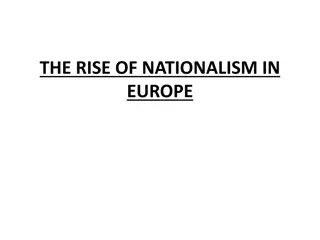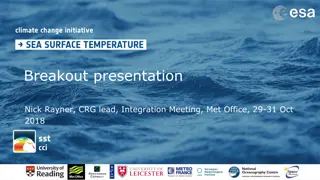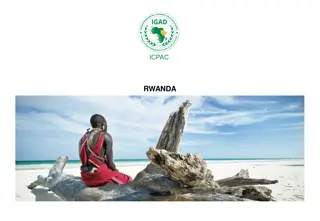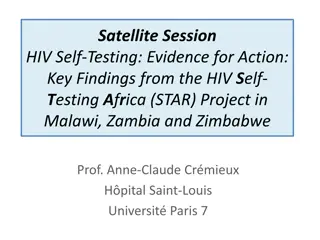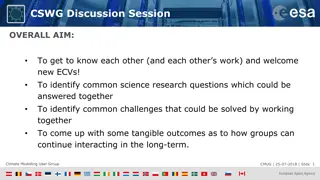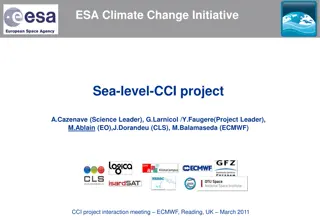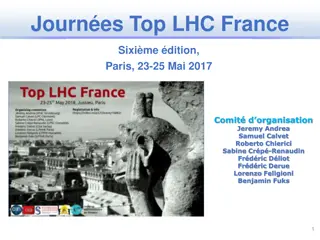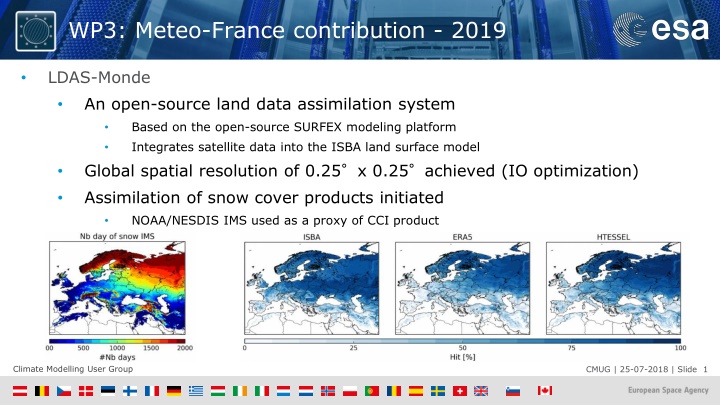
Meteo-France 2019-2020 Contributions on LDAS-Monde and CMUG Integration
This content highlights Meteo-France's contributions in 2019 and 2020 related to LDAS-Monde, an open-source land data assimilation system, and their involvement in the Climate Modelling User Group (CMUG) integration. The focus is on assimilating snow cover products, evaluating LST-SM-LAI, utilizing Copernicus Global Land Service data, and aiming for consistency and best practices within the climate research community.
Download Presentation

Please find below an Image/Link to download the presentation.
The content on the website is provided AS IS for your information and personal use only. It may not be sold, licensed, or shared on other websites without obtaining consent from the author. If you encounter any issues during the download, it is possible that the publisher has removed the file from their server.
You are allowed to download the files provided on this website for personal or commercial use, subject to the condition that they are used lawfully. All files are the property of their respective owners.
The content on the website is provided AS IS for your information and personal use only. It may not be sold, licensed, or shared on other websites without obtaining consent from the author.
E N D
Presentation Transcript
WP3: Meteo-France contribution - 2019 LDAS-Monde An open-source land data assimilation system Based on the open-source SURFEX modeling platform Integrates satellite data into the ISBA land surface model Global spatial resolution of 0.25 x 0.25 achieved (IO optimization) Assimilation of snow cover products initiated NOAA/NESDIS IMS used as a proxy of CCI product Climate Modelling User Group CMUG | 25-07-2018 | Slide 1
WP3: Meteo-France contribution - 2020 LDAS-Monde Assimilation of snow cover products finalized Start the cross-cutting evaluation of LST-SM-LAI (3.1) Copernicus Global Land Service LST product can be used as a proxy First version of CCI product will be used Snow-SM-LAI (3.2) 1 week stay of Cl ment Albergel at ECMWF: link to the Snow-CCI project Benchmarking with IMS product First version of CCI product will be used Permafrost-SM-LAI (3.3) First version of CCI product will be used Climate Modelling User Group CMUG | 25-07-2018 | Slide 2
Welcome to CMUG Integration Meeting #9 Wednesday 6 & Thursday 7 November 2019 Barcelona Super Computer Centre Climate Modelling User Group CMUG | 25-07-2018 | Slide 3
Aims of the meeting Prof. Richard Jones, Met Office, CMUG Lead Scientist 1. Presentation and discussion of CMUG results 2. Discussion of ECV User Requirements (wrt needs of the Climate Research Community, CMUG and GCOS requirements) 3. Discuss the emerging product specifications for the new ECVs 4. Examine how projects are addressing an integrated perspective for consistency between ECVs 5. Discuss how to deal with uncertainties in products (how to capture and describe them for users) 6. Develop ECV projects' data needs for ECMWF reanalysis data 7. Allow CMUG and the existing ECV teams to demonstrate 'best practice' to the new ECV teams 8. Maintain oversight of the position within the international framework in which CMUG/CCI is operating Climate Modelling User Group CMUG | 25-07-2018 | Slide 4
Inputs to the meeting 1. You!! The ECV teams and other CCI projects 2. Experts from C3S, GCOS, WCRP, EUMETNET, Future Earth, FIDUCEO, UKESM 3. CMUG results (URD, FR, DAR, QAR, MIP, SER, CS, ESMValTool) 4. Documentation from ECVs (URDs, DARDs, CECRs, etc) 5. ESA CCI Project Guidelines [http://cci.esa.int/sites/default/files/ESA_CCI_Project_Guidlines_V1.pdf] 6. GCOS requirements [https://public.wmo.int/en/programmes/global-climate- observing-system/essential-climate-variables] 7. CCI Uncertainty paper 8. CCI Consistency paper Climate Modelling User Group CMUG | 25-07-2018 | Slide 5
Planned meeting outputs A report informed by the following: 1. Actions agreed by CCI projects, and by CMUG 2. Materials to inform CCI and CMUG research 3. Potential for joint CMUG / CCI scientific exploitation 4. CMUG / CCI outreach/engagement in the international arena 5. Clarity on requests for ECMWF reanalysis data 6. Feedback on Integration 9: what you liked and what could be improved Climate Modelling User Group CMUG | 25-07-2018 | Slide 6
CMUG Objectives relevant to this meeting 1. Support integration within the CCI programme - through requirements and user assessment from data users - through feedback from a climate system perspective 2. Foster the exploitation of Satellite-derived Essential Climate Variables (ECVs) - by promoting the use of CCI data sets to climate modellers. - by building partnership and links with existing research organisations, networks and scientific bodies of the Climate Modelling Community. 3. Assess quality and impact of individual/combined Global Satellite Data Products in Climate Model and Data Assimilation contexts - by assessing suitability of products for climate applications (e.g. climate modelling, decadal prediction, reanalysis, etc) - by quantifying their added value on model performance in an objective manner Climate Modelling User Group CMUG | 25-07-2018 | Slide 7
CMUG current activities and results Updated USER REQUIREMENTS for climate modelling applications, reanalyses, and Climate Services, and compared them with CCI ECV specifications Assess the QUALITY AND CONSISTENCY of multiple CCI datasets in combination using state of the art climate models and provide FEEDBACK on this to the CCI teams EXPLOIT CCI DATASETS through a Model Intercomparison Project (SST, Sea Ice, Aerosol, Land Cover, Soil Moisture, Fire) using two different climate model Adapt climate EVALUATION TOOLS for CCI NEEDS the Climate Monitoring Facility at ECMWF and the ESMVal tool will be developed for use on CCI data Provide the CCI teams with an INTEGRATED PERSPECTIVE on research issues (uncertainty, data, Obs4MIPs) Actively PROMOTECCI DATASETS to the climate modelling and climate research communities through scientific engagement with programmes and initiatives (e.g. engaging with Horizon 2020 climate research projects, the CCI Data Forum) ENGAGEMENT at an INTERNATIONAL LEVEL to ensure CCI datasets reach researchers around the world (e.g. through IPCC reports, GCOS, other international and regional initiatives) Climate Modelling User Group CMUG | 25-07-2018 | Slide 8
Climate Modelling User Group CMUG | 25-07-2018 | Slide 10
CMUG report on User Requirements Purpose: to assist the CCI ECV and X-cutting projects on the needs of the Climate Modelling Community (CMC), Climate Research Community (CRC) and other expert users of climate data. 1) present an analysis of the satellite observation climate data requirements of the above communities (including C3S and other CS), detection and attribution of climate change, climate process studies, climate change impacts and climate/environmental monitoring. 2) covering the requirements for the 23 ECVs in terms of parameters, resolution and errors/uncertainties (and observation operators). 3) address the requirements for CCI datasets to be included in the Copernicus Climate Change Service and the Obs4MIPs interface. 4) cover overarching technical requirements and scientific linkages for the datasets Climate Modelling User Group CMUG | 25-07-2018 | Slide 11
CMUG report on User Requirements Starting Point 1) GCOS requirements (updated every 5+ years). 2) To inform other international initiatives (WCRP grand challenges, IPCC future research needs, UNFCCC Global Stocktake, ...) 3) The Climate Modelling Community, including the Obs4MIPs initiative. 4) C3S and other Climate Services 5) Expert users of climate information (Adaptation community, Insurance industry, ...) 6) The known requirements that were used to develop the 14 CCI ECVs . Climate Modelling User Group CMUG | 25-07-2018 | Slide 12
CMUG report on User Requirements The process of gathering requirements and supporting information: 1) Climate Science papers 2) High level strategy documents 3) EXPERTS - Online survey - Interviews - User groups Climate Modelling User Group CMUG | 25-07-2018 | Slide 13
CMUG report on User Requirements Responses: 144 ECV replies from 53 experts GHG SLR Climate Modelling User Group CMUG | 25-07-2018 | Slide 14
CMUG report on User Requirements Climate Modelling User Group CMUG | 25-07-2018 | Slide 15
CMUG report on User Requirements Definition of boundary conditions Development of statistical downscaling Climate Modelling User Group CMUG | 25-07-2018 | Slide 16
CMUG report on User Requirements Coupled modelling Full Earth system (inc. bio-geo-chem) Atmosphere only modelling Climate Modelling User Group CMUG | 25-07-2018 | Slide 17
CMUG report on User Requirements Climate Modelling User Group CMUG | 25-07-2018 | Slide 18
CMUG report on User Requirements Climate Modelling User Group CMUG | 25-07-2018 | Slide 19
CMUG report on User Requirements Climate Modelling User Group CMUG | 25-07-2018 | Slide 20
CMUG report on User Requirements Climate Modelling User Group CMUG | 25-07-2018 | Slide 21
CMUG report on User Requirements Climate Modelling User Group CMUG | 25-07-2018 | Slide 22
CMUG report on User Requirements Climate Modelling User Group CMUG | 25-07-2018 | Slide 23
CMUG report on User Requirements Climate Modelling User Group CMUG | 25-07-2018 | Slide 24
D2.3 Assessment of CCI Technical Documentation Climate Modelling User Group CMUG | 25-07-2018 | Slide 25
D2.3: Assessment of product documentation PURPOSE: to update the existing report (currently 3-years old) 1. To assess project deliverable documents such as: Product validation and inter-comparison Report Climate Assessment Report Comprehensive Error Characterisation Report Others e.g. Product specification document, User requirement document - - - - 2. Give feedback to ESA and the CCI teams: - Through assessment of Quality, Uncertainty, and Maturity of the product Climate Modelling User Group CMUG | 25-07-2018 | Slide 26
Assessment of product documentation Existing ECVs New ECVs Climate Modelling User Group CMUG | 25-07-2018 | Slide 27
Existing ECVs ECV Quality Uncertainty Maturity GCOS requirements SST Ocean Colour SSH Sea Ice Clouds X X Aerosols GHG Ozone Land Cover Fire Soil Moisture Greenland IS Antarctic IS Climate Modelling User Group CMUG | 25-07-2018 | Slide 28
New ECVs ECV Quality X Uncertainty Maturity X X X X GCOS requirements X X X X X Water Vapour X X X Sea Surface Salinity Sea State X X Lakes Snow Permafrost Land Surface Temperature High res. land cover Above Ground Biomass X X X Climate Modelling User Group CMUG | 25-07-2018 | Slide 29
Assessment of product documentation For Essential Climate Variables: Climate Modelling User Group CMUG | 25-07-2018 | Slide 30
Land ECVs ECV Land Cover Quality X Uncertainty X Maturity X GCOS requirements X Fire Soil Moisture Lakes* Land Surface Temperature* High res. land cover* Above Ground Biomass* *new ECV X X X Climate Modelling User Group CMUG | 25-07-2018 | Slide 31
Ocean ECVs ECV Quality Uncertainty X X Maturity X X GCOS requirements SST Ocean Colour SSH X X Sea Surface Salinity* Sea State* *new ECV Climate Modelling User Group CMUG | 25-07-2018 | Slide 32
Atmosphere ECVs ECV Clouds Quality X Uncertainty Maturity X GCOS requirements X Aerosols GHG Ozone Water Vapour* *new ECV Climate Modelling User Group CMUG | 25-07-2018 | Slide 33
Cyrosphere ECVs ECV Quality X Uncertainty Maturity GCOS requirements X X X Greenland IS Antarctic IS Snow* Permafrost* Sea Ice *new ECV Climate Modelling User Group CMUG | 25-07-2018 | Slide 34
D2.1: Earth Observation Foresight Report Aim: To assess requirements for Earth Observation developments to provide support to the climate modelling and information community Objective: To inform the new ESA Climate Programme proposal for 2022 via a broad community consultation Lead author: Richard Jones, CMUG Science Leader Met Office Hadley Centre (Oxford University) Contributing authors from CMUG partners (ECMWF, IPSL, MPI-Met, Meteo France, BSC, DLR, SMHI) and CCI project Science Leaders (covering 25 CCI ECVs and Cross-ECV activities). Review by climate modelling/information/services stakeholders Climate Modelling User Group CMUG | 25-07-2018 | Slide 35
Report Structure 1. High Level Drivers of Requirements for EO data, information and services 2. Climate information and services requiring EO data and research 3. EO activities required to enable and deliver the information and services 4. Gap Analysis 5. Conclusions/Recommendations Climate Modelling User Group CMUG | 25-07-2018 | Slide 36
High level drivers (1) UNFCCC requirements on monitoring, attribution and projections of climate change, its implications and response options Main conduit for information is via IPCC WGI-III assessments and Special Reports Requires indicators and measurements of: - the causal factors of climate change (e.g. GHGs, land cover change) - changes in the physical climate, natural and human systems - trends in vulnerability and exposure factors (e.g. urbanization, land-use) Leading to improvements in scientific understanding (e.g. WCRP Grand Challenges) Supporting better predictions of future impacts/responses via assessment of: - needs for adaptation and building resilience - mitigation options Climate Modelling User Group CMUG | 25-07-2018 | Slide 37
High level drivers (2) UN 2030 Agenda for Sustainable Development SDGs generally have climate sensitivities: agriculture, water, health, infrastructure etc are at risk from climate-related hazards so building resilience to these can contribute significantly to SDG attainment Sustainable Development Goals Climate Modelling User Group CMUG | 25-07-2018 | Slide 38
High level drivers (3) UN Sendai Framework for Disaster Risk Reduction (2015 2030) Priorities: 1. Understanding (e.g. vulnerability, exposure, hazard characteristics) 2. Strengthening governance and management 3. Investing in resilience 4. Enhancing preparedness, response capacity, and recovery Climate-related to climate: Improve understanding of current and projected future risks from climate hazards Development of risk reduction strategies: early warning systems, index insurance Assess potential for future intolerable risks (links back to UNFCCC/PA Article 8) Climate Modelling User Group CMUG | 25-07-2018 | Slide 39
High level drivers (4) Biodiversity and Ecosystem Services UN Convention on Biological Diversity (UNCBD) and the Intergovernmental Science Policy Platform on Biodiversity and Ecosystem Services (IPBES) Essential Biodiversity Variables (Biodiversity Observation Networks: GEO-BON) - e.g. phenology, NPP, ecosystem extent and fragmentation. Climate Modelling User Group CMUG | 25-07-2018 | Slide 40
High level drivers (5) Economy (with links to SDGs, UNFCCC mitigation etc) Many climate-sensitive sectors of the economy would benefit from improved climate information and prediction, e.g. agriculture offshore engineering and maritime operations renewable energy (solar, wind, hydro, biofuels) workforce productivity (impact of heatwaves, vector borne diseases such as malaria, buruli worm, dengue, etc.) Sustainable Economic Development Economic development in some countries could become unsustainable as a result of future climate change, reversing recent progress in poverty reduction. Accurate predictions of future limitations and adaptation strategies are needed. Climate Modelling User Group CMUG | 25-07-2018 | Slide 41
Climate Information Services Requiring EO, 1 Monitoring and Reanalysis Detection and scientific understanding of long term changes in climate and the functioning of the Earth System (e.g. water, carbon, energy cycles) Monitoring of natural resources (e.g. water resources and quality, land cover) Modelling and Attribution of Climate Variability, Change and Impacts/Risks Accurate climate and impact prediction relies on accurate models, and therefore on model verification and process evaluation against observations. Attribution of impacts/risks to changes in hazards needs observations of changes in possible confounding factors of vulnerability and exposure Anthropogenic drivers of change (e.g. GHG sources and sinks, land cover) High resolution fields for model downscaling Climate Modelling User Group CMUG | 25-07-2018 | Slide 42
Climate Information Services Requiring EO, 2 Seasonal to Decadal Forecasting To inform society and decision makers in climate-sensitive sectors (agriculture, energy, tourism, health) Long term ECVs are essential for model initialisation and validation Building Climate Resilience and Adaptation Downscaling climate predictions to understand local impacts Provision of detailed local information required to design interventions to build resilience to future climate change (e.g. mapping of mangroves, forests, wetlands, lake water quality, glacier water resources, soil degradation, urban expansion and heat islands, air quality, etc) Climate Modelling User Group CMUG | 25-07-2018 | Slide 43
EO activities required for services (1) Improving Assimilations and Reanalysis e.g. Develop assimilation of land observations to improve reanalysis (ERA5- Land is a land model driven by the atmos reanalysis, not a model analysis of land observations) Give high priority to data-poor regions, poorly observed parameters, regions sensitive to change, and key measurements with inadequate temporal resolution. Attribution and Modelling of Climate Variability and Change Cross-ECV budget/cycle analysis: provide observational constraints to improve model capabilities to predict future changes. Would also highlight key gaps in the observation network. New short-term ECVs for model process evaluation (e.g. EarthCARE) Climate Modelling User Group CMUG | 25-07-2018 | Slide 44
EO activities required for services (2) New and Improved Climate Data Records R&D to integrate data from new/future instruments: e.g. Sentinels, S-HPCMs, S- NGs, Earth Explorers, Altius, TRUTHS, MTG/Metop-SG, ... New GCOS requirements: e.g. GHG fluxes; better cross-ECV consistency to address climate cycles and budgets R&D to integrate valuable data from early instruments (~1960-1990), including data rescue activities (e.g. to collect regional direct broadcast archives) New ECV products: e.g. Vegetation Optical Depth, sea-ice snow depth, snow albedo, melt pond coverage, ... High resolution data sets for local adaptation activities (e.g. support to international development projects, civil protection agencies, NGOs) Respond to specific requirements from climate services Climate Modelling User Group CMUG | 25-07-2018 | Slide 45
Gap Analysis Task to be completed: Q1: What more is needed beyond what already exists or is already planned? Take into account: Existing climate services (Copernicus C3S, national, GFCS) Existing R&D programmes (WCRP, national, Horizon Europe, ESA, ...) Activities of other space agencies (EUMETSAT, NASA, ...) Q2: What of the above falls within ESA's mandate? Focus on maximising the benefits from ESA's and ESA Member States' satellite infrastructure. Q3: What are the highest priorities, and provides the greatest benefit vs. cost Climate Modelling User Group CMUG | 25-07-2018 | Slide 46
WP3: quality assessment of CCI products J.-C. Calvet on behalf of WP3 partners ESA UNCLASSIFIED - For Official Use
WP3: quality assessment of CCI products Objective Assess consistency and quality of CCI products Across ECVs Using climate (sub-)models and reanalyses Effort: 50 pm Meteo-France (13 pm) 3.1, 3.2, 3.3 + coordination BSC (15 pm) 3.4, 3.8, 3.10, 3.11 ECMWF (9 pm) 3.12 IPSL (8 pm) 3.5, 3.6 Met Office (5 pm) 3.7, 3.9 Climate Modelling User Group CMUG | 25-07-2018 | Slide 48
WP3: BSC contribution - 2019 LST-SM-BA SIC and LST-BA SSal-SST-SI-Clds HRLC-Aero-LC Climate Modelling User Group CMUG | 25-07-2018 | Slide 49
WP3: BSC contribution - 2020 SIC and LST-BA SSal-SST-SI-Clds HRLC-Aero-LC Climate Modelling User Group CMUG | 25-07-2018 | Slide 50
WP3: ECMWF contribution - 2020 Ozone and AOD (3.12) Assimilation of S3 AOD and S5P O3 retrievals in the IFS (CAMS configuration) Assessment of the Impact on analyses and forecasts Consistency with other assimilated observations, independent observations, ERA5 Possible synergies with other observations Climate Modelling User Group CMUG | 25-07-2018 | Slide 51







